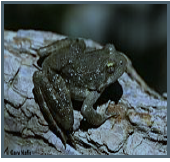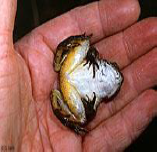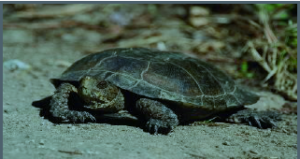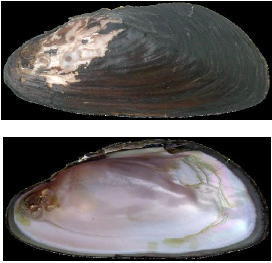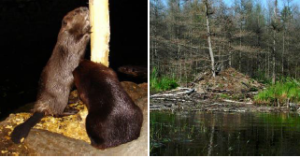Yuba Field Guide Watershed Species to Know
Yuba Field Guide
A look at our watershed’s sensitive and invasive animal species
Foothill Yellow Legged Frog (Rana boylii) Sensitive Native
Description
- Rough Skin, with olive coloring
- Pale yellow triangle extending from tip of nose to between eyes
- No eardrum (circle) behind eye
- Yellow coloring on legs, abdomen
- Do not make clear audible noises
Habitat
- Found in close association with water, but can utilize a variety of aquatic habitats including pools, riffles, runs, cascade pools, and step pools
- Prefer areas with exposed basking sites
Tips for a confirmed sighting: - Picture
Don’t confuse with….
Bullfrog (Rana catesbeiana) which has:
- Bright green mouth/throat, smooth shiny skin, large eyes relative to head and large eardrum behind eye, white belly, legs, and abdomen
- Non-Native
Western Toad (Bufo boreas) which has:
- Warty skin and thin white stripe behind center of back
- Native
Pacific Treefrog (Hyla regilla) which has:
- Distinct black eye strip, smaller legs, non-webbed
Western Pond Turtle (Actinemys marmorata) Sensitive Native
- Only native freshwater turtle in California
- Contains radiating lines from center of shell plates
- No red stripe on face
Habitat
- Use both land and aquatic habitat
- Needs hiding and basking sites, nesting habitat, permanent slow-moving water with deep and shallow areas
Tips for a confirmed sighting:
- Picture; shell
Don’t confuse with….
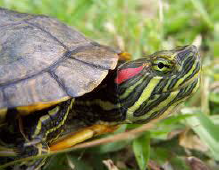 Red-Eared Slider (Trachemys scripta) which has:
Red-Eared Slider (Trachemys scripta) which has:
- Red on neck
- Non-native
California Horned Lizard (Phrynnosoma coronatum frontale) Sensitive Native
- Flattened body with backwardly
projecting head spines - Large shelf above each eye with a
spine-like scale, small scales on
forehead, and two parallel rows of
pointed scales on each side of its body - Variable coloration, but usually gray,
tan, reddish-brown or whitish
Habitat
- They can be found in various habitat
types, including riparian habitats,
grasslands, and oak woodlands - Endemic to California
Tips for a confirmed sighting:
- Picture
Western Ridged Mussel (Gonidea angulata) Sensitive Native
- Shell is yellowish-brown to black or
brown and up to 5” in size - Shell does not have rays or sculpturing
- Shell has angular ridge that runs along
the posterior margin, while the
anterior margin is generally straight
Habitat
- Bottoms of streams and rivers with
substrates that vary from gravel to
firm mud, and some sand, silt or clay - Rarely seen in reservoirs or lakes
Tips for a confirmed sighting:
- Picture;
- Shell
Don’t confuse with….
California Floater (Anodonta californiensis) which has:
- Shell is elliptical or ovate; olive
green, pale brown, reddish brown or
black - Has greenish rays on posterior slope;
outside of shell is smooth with
growth lines - Native
River Otter (Lontra canadensis) Sensitive Native
Description
- Streamlined body adapted for aquatic life
- Short limbs with webbed, clawed paws and a broad muzzle
- Thick body with thick tapering tail
- Outer fur is brown to velvety black, underside paler grayish-brown to silver
- About the size of a medium dog; length of head and body about 26-30 inches
Habitat
- Must live near permanent water, but can live in a variety of aquatic habitats
- Generally live along river banks in holes
Tips for a confirmed sighting:
- Picture
Don’t confuse with….
Mink (Mustela vison)
- Slightly smaller than a domestic cat; length of head and body about 12-17 inches
- Medium to dark brown with a white chin patch
- Native
Beaver (Castor canadensis)
- Built in a shorter and stockier manner
- Elongated tail, flattened tail
- Native
Beaver (Castor canadensis) Sensitive Native
- Largest rodents in North America
- Waterproof reddish brown or blackish brown coat
- Hind legs are longer than front legs, flattened tail
- Disproportionately large head and teeth; length of head and body about 25-30 inches
Habitat
- Often found in ponds and lakes
- Needs hiding and basking sites, nesting habitat, permanent slow-moving water with deep and shallow areas
- Live in lodges that they construct
Tips for a confirmed sighting:
- Picture of beaver or lodge
Don’t confuse with….
River Otter (Lontra Canadensis)
- Longer, thinner body
- Tail also long but tapered not flattened
- Native
Muskrat (Ondatra zibethicus)
- Thin, scaly tail, flattened on sides
- Length of head and body about 10-14 inches
Osprey (Pandion haliaetus) Sensitive Native
- Large raptor with white breast and belly
- Black back and wings; crown and forehead white; dark eyestripe
- Long wings with wingtips angled slightly backwards.
- Larger than a hawk, smaller than a bald eagle
Habitat
- Lives near water bodies as they eat almost exclusively fish
Tips for confirmed sighting:
- Picture
Don’t confuse with….
Bald Eagle (Haliaeetus leucocephalu
- White head and tail feathers, no eyestripe
- Native, CA Endangered Species
Red Tailed Hawk (Buteo jamaicensis)
- Red tail, but juveniles and some adults can be light in color
- Native
Did you enjoy this post?
Get new SYRCL articles delivered to your inbox by subscribing to our ENews.


